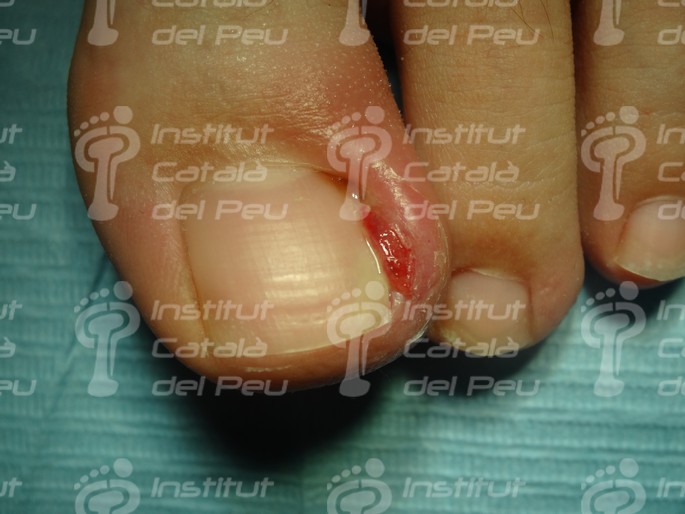The onychocryptosis or commonly known as ingrown nail, it is an unguinal pathology in which the nail is ingrown or got through the skin causing pain, inflammation and toe reddening. In a late stage it can originate a secondary pyogenic infection. Most of ingrown nails appear in the big toe and they are more usual among adolescents and young people with a higher percentage in male sex.
These are the main factors which cause an ingrown nail:
- A longer big toe than the rest of toes or in hyperextension.
- Tight or pointed shoes.
- The unguinal morphology. Nails with lateral rims in a very vertical position or curved facing the skin and they appear in a similar way than a staple driving these rims.
- Traumatisms or wrong nail cuts in the unguinal layer. In these cases it is characteristic the appearance of a spicule or “harpoon” originator of the onychocryptosis.
- Pronation of the front side of the foot.
- The maceration of soft tissues helps the penetration of the unguinal layer.
All these factors help an increase of the unguinal pressure over the soft tissue marking a mild pain at the beginning and when hours pass, it grows the intensity and frequency.
There are four stages in which the onychocryptosis is classified.
Stage I: Appearance of a slight edema and pain when putting pressure on the nail fold and not exceeding this one the unguinal layer.
Stage II: More pain, erythema and appearance of serious or infectious exudation. The hypertrophiated roller exceeds the unguinal layer.
Stage III: There is a growth of the symptoms of the former stage. It is characterized by the appearance of a granulation tissue and chronic hypertrophia of the roller covering partially the unguinal layer.
Stage IV: Serious and chronic deformity of the nail and the periungual rollers.
The immediate treatment will be directed to reduce pain, inflammation and infection, in case it exists.
For this purpose we will use a straight metal shears or a scalpel cutting the lateral side of the nail in a soft diagonal way and always behind the spicule which causes the lesion. Once the spicule or the unguinal rim is removed, we will apply an antibiotic and/or anti-inflammatory cream depending on the situation of the affected toe.
The treatment in a middle term (10 days approximately), and in case the roller inflammation remains, it will lie in the application of Burow water or calcined alum in order to reduce this inflammation. Other treatments will involve using corrective orthesis either digital unloading or unguinal checkers.
The treatment in a long term implies the resolution of the ingrown nail through the surgical technique. Surgery it is usually reserved for frequent recidivations or for the appearance of pyogenic granulomas or hypertrophiated rollers which will continue to appear the onychocryptosis or ingrown nails.
Regarding the surgical technique we will not extend to this issue because you can look it up in our blog other issues related to surgical methods.
Onychocryptosis in stage I.
Onychocryptosis in stage II.
Onychocryptosis with bilateral granuloma.
Onychocryptosis with a pyogenic infection.
Onychocryptosis in stage II.
Onychocryptosis in stage III. You can see the appearance of one granuloma in the tibial canal.
Removal of spicule caused by cutting the nail incorrectly. You can see the “harpoon” shape.
Onychocryptosis in stage II.
Onychocryptosis in stage II.
